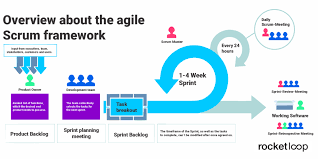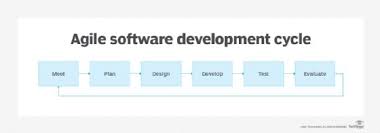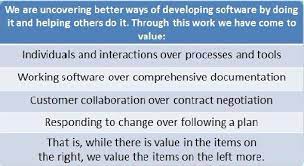Agile software development is an iterative approach to software development that focuses on collaboration, flexibility, and speed. It is a process that enables teams to quickly respond to changing customer needs and market conditions.
Agile software development was first proposed in 2001 as a way to address the challenges of traditional software development methods, which can be slow and inflexible. Agile approaches emphasize customer collaboration, continuous iteration and improvement, and rapid delivery of working software. By taking an agile approach, teams are able to deliver working software more quickly and with higher quality.
Agile development relies heavily on collaboration between developers, customers, and stakeholders. The goal is to create an environment where everyone can work together effectively in order to achieve the desired outcomes. Agile teams focus on customer feedback throughout the process so that they can quickly make changes as needed. This helps ensure that the final product meets customer expectations.
Agile teams also use iterative methods for developing software. Instead of trying to build the entire product at once, they break it down into smaller pieces that can be developed and tested more quickly. This allows teams to get feedback from users early in the process so they can make adjustments as needed before releasing a final product.
Finally, agile teams focus on delivering working software as soon as possible rather than waiting until all features are complete. This helps them get feedback from users more quickly so they can continue improving their product over time.
In summary, agile software development is an iterative approach that focuses on collaboration between developers and customers, continuous improvement through iteration, and rapid delivery of working software. By taking an agile approach, teams are able to deliver high-quality products faster while responding quickly to changing customer needs.
Here are 9 tips for successful agile software development.
- Start with a goal-oriented mindset: Focus on what you want to achieve, rather than how you want to do it.
- Embrace change: Agile software development is all about adapting quickly to changes and evolving the product as needed.
- Prioritize customer feedback: Listen to your customers and use their feedback to inform your decisions and prioritize tasks accordingly.
- Break down large projects into smaller chunks: This will help keep the team focused, increase productivity, and reduce risk of failure due to scope creep or other issues.
- Use iterative development cycles: This will allow for quick iterations of the product based on customer feedback and help ensure that the final product meets customer needs in a timely manner.
- Encourage collaboration between team members: Communication between different departments will improve efficiency and create better products faster by leveraging each other’s expertise and experience in different areas of the project.
- Implement testing early on in the process: Testing should be done throughout development cycles so any bugs can be identified quickly before they become bigger problems later down the line.
- Measure progress regularly: Regularly review progress against goals so that any issues can be addressed immediately and adjustments made if necessary for successful completion of the project within time constraints set out at start of development cycle .
- Be flexible but stay focused : Agile software development requires flexibility but also staying focused on achieving goals within set timelines .
Start with a goal-oriented mindset: Focus on what you want to achieve, rather than how you want to do it.
Agile software development is a methodology that focuses on delivering high quality products in a short amount of time. To make sure that you are successful in this endeavor, it is important to start with a goal-oriented mindset. This means that you should focus on what you want to achieve, rather than how you want to do it.
By having a clear goal in mind, it will be easier to prioritize tasks and break down the project into manageable chunks. This will help ensure that the project progresses quickly and efficiently, as each task will be focused on achieving the desired outcome. Additionally, by prioritizing goals over processes, teams can be more creative and adaptive when developing solutions.
Finally, a goal-oriented mindset will also help keep teams motivated during the project. By focusing on the end result, teams can stay focused and energized throughout the entire process.
In conclusion, starting with a goal-oriented mindset is essential for successful agile software development projects. By focusing on what needs to be achieved rather than how it needs to be done, teams can stay motivated and creative while developing high quality products quickly and efficiently.
Embrace change: Agile software development is all about adapting quickly to changes and evolving the product as needed.
Agile software development is a popular methodology that has been embraced by many software development teams. It focuses on rapid delivery of working software and encourages collaboration between developers, customers, and stakeholders. One of the key principles of agile development is to embrace change.
Change is inevitable in software development, and agile teams must be prepared to adapt quickly to changing requirements and feedback. Agile teams should strive to continuously improve their product by responding to feedback from customers, stakeholders, and end users. This means that changes should be implemented quickly and efficiently, with minimal disruption to existing processes.
Agile teams should also work closely together in order to ensure that everyone understands the goals of the project and how changes will affect the product. This includes discussing any potential risks or challenges associated with making changes, as well as how they can be addressed in a timely manner.
By embracing change, agile teams can ensure that their product remains up-to-date with customer needs and expectations. This helps them stay ahead of the competition and deliver a more valuable product for their customers.
Prioritize customer feedback: Listen to your customers and use their feedback to inform your decisions and prioritize tasks accordingly.
Agile software development is a popular method of software development that emphasizes collaboration, iteration, and customer feedback. One key tip for successful agile development is to prioritize customer feedback. By listening to customers and taking their feedback into account, developers can ensure that their projects are in line with customer expectations and needs.
To prioritize customer feedback, developers should actively seek out customer opinions and use them to inform decisions and prioritize tasks. This could involve conducting surveys or interviews with customers to get a better understanding of their preferences. Developers should also keep track of any comments or reviews customers leave about their product or service so they can make changes as needed.
By taking the time to listen to customers and use their feedback to inform decisions, developers can ensure that their projects meet customer needs and expectations. This will help them create better products that are more likely to be successful in the long run.
Break down large projects into smaller chunks: This will help keep the team focused, increase productivity, and reduce risk of failure due to scope creep or other issues.
Agile software development is an increasingly popular methodology for creating software. One of the most important tips in this approach is to break down large projects into smaller chunks. Doing so will help the team stay focused and increase productivity, while also reducing the risk of failure due to scope creep or other issues.
Breaking down large projects into smaller chunks allows teams to focus on one task at a time, which helps ensure that each part of the project is completed correctly and efficiently. This also helps reduce the risk of scope creep, which can happen when teams are working on a larger project without breaking it down into smaller pieces. By breaking it down, teams can better manage their tasks and ensure that they stay on track with their goals.
In addition, breaking down large projects into smaller chunks also reduces the risk of failure due to other issues such as miscommunication or lack of resources. By focusing on one task at a time, teams are able to better plan out their resources and communicate more effectively with each other, which increases the chances of success for any given project.
Overall, breaking down large projects into smaller chunks is an essential tip for agile software development. By doing so, teams can stay focused, increase productivity, and reduce the risk of failure due to scope creep or other issues.
Use iterative development cycles: This will allow for quick iterations of the product based on customer feedback and help ensure that the final product meets customer needs in a timely manner.
Agile software development is a popular approach to creating software that emphasizes speed and flexibility. One key way to ensure an agile process is to use iterative development cycles. Iterative development cycles allow for quick iterations of the product based on customer feedback. This helps ensure that the final product meets customer needs in a timely manner.
Iterative development cycles involve breaking down the software development process into smaller, more manageable chunks. Each chunk is then tested and refined before moving on to the next step in the process. This allows for rapid prototyping and feedback loops, which help identify areas of improvement quickly and efficiently. Additionally, it allows for changes to be made quickly and easily as customer feedback comes in.
Overall, iterative development cycles are an important part of agile software development as they help ensure that the final product meets customer needs in a timely manner. By breaking down the process into smaller chunks, it also allows for rapid prototyping and feedback loops which help identify areas of improvement quickly and efficiently.
Encourage collaboration between team members: Communication between different departments will improve efficiency and create better products faster by leveraging each other’s expertise and experience in different areas of the project.
Agile software development is a popular methodology for creating software applications that are efficient and high-quality. One of the key components of successful agile development is encouraging collaboration between team members. Communication between different departments helps to improve efficiency, leading to better products being created faster.
By leveraging each other’s expertise and experience in different areas of the project, teams can create more effective solutions to problems as they arise. This also allows for a greater understanding of the overall project goals and objectives, as well as how each team member can contribute to achieving them. Additionally, it helps to foster trust and camaraderie among team members, which in turn leads to better communication and collaboration.
Encouraging collaboration between team members is an essential part of agile software development. It not only helps with efficiency but also creates a more positive work environment where everyone feels valued and heard. By taking the time to foster open communication between departments, organizations can ensure that their projects are successful and completed on time.
Implement testing early on in the process: Testing should be done throughout development cycles so any bugs can be identified quickly before they become bigger problems later down the line.
Agile software development is a popular methodology used by many software developers. One of the key benefits of this approach is its focus on testing early and often. Implementing testing early on in the process helps to ensure that any bugs or issues are identified quickly, before they become bigger problems later on.
Testing should be done throughout development cycles, not just at the end. This allows for any issues to be identified and addressed as soon as possible, reducing the risk of costly delays or rework further down the line. By implementing testing early, developers can also identify potential improvements that could be made to their code or design.
In addition to helping identify potential issues, implementing testing early can also help to improve communication between different teams involved in a project. By ensuring that everyone is aware of any potential bugs or problems, teams can work together more efficiently and effectively to resolve them.
Overall, it is clear that implementing testing early on in the process is essential for successful agile software development projects. Not only does it help to identify any potential issues quickly, but it also helps to improve communication between teams and ensure a successful outcome for all involved.
Measure progress regularly: Regularly review progress against goals so that any issues can be addressed immediately and adjustments made if necessary for successful completion of the project within time constraints set out at start of development cycle .
Agile software development is a popular methodology used to create software applications and systems. One of the key principles of agile development is to measure progress regularly. This means regularly reviewing progress against goals, so that any issues can be addressed immediately and adjustments can be made if necessary for successful completion of the project within time constraints set out at the start of development cycle.
Regular progress reviews ensure that teams can identify and address any problems early on in the project, before they become too large or difficult to fix. This helps ensure that projects stay on track and within budget. It also allows teams to make changes quickly, ensuring that the end product meets customer requirements and expectations.
Regular progress reviews also provide a great opportunity for teams to review their processes and make improvements where necessary. By taking a step back and looking at how things are progressing, teams can identify areas where they can become more efficient or streamline their workflow. This helps ensure that projects are completed in a timely manner without sacrificing quality or customer satisfaction.
Overall, measuring progress regularly is an important part of agile software development that should not be overlooked. Regular reviews help teams stay on track, make improvements where necessary, and deliver high-quality products on time and within budget.
Be flexible but stay focused : Agile software development requires flexibility but also staying focused on achieving goals within set timelines .
Agile software development is a popular methodology for software development that emphasizes collaboration, flexibility and rapid delivery of products. It is an iterative process that encourages teams to work together to create high-quality products in a short amount of time.
The key to successful agile software development is to be flexible but stay focused on achieving goals within set timelines. This means that teams must be willing to adjust their plans as needed in order to meet customer demands and stay on track. They must also remain focused on their goal, so that they don’t get sidetracked or waste time on activities that don’t contribute towards the end product.
Agile teams should also continuously evaluate their progress and make changes as needed. This means regularly reviewing the project plan and making adjustments based on customer feedback or changes in technology. By being flexible yet staying focused, teams can ensure that their projects are delivered on time and within budget.
In conclusion, agile software development requires a balance between flexibility and focus in order to achieve success. Teams must be willing to adjust their plans as needed while still keeping the end goal in mind. By doing this, they can ensure that their projects are completed quickly and efficiently, while still meeting customer needs.




